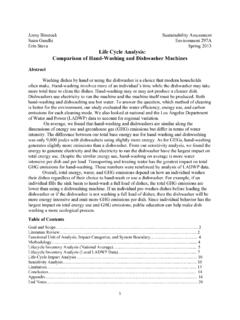Transcription of Lifecycle Analysis Comparison of a Battery Electric ...
1 Lifecycle Analysis Comparison of a Battery Electric Vehicle and a Conventional Gasoline Vehicle Kimberly Aguirre Luke Eisenhardt Christian Lim Brittany Nelson Alex Norring Peter Slowik Nancy Tu Advisor: Dr. Deepak Rajagopal Client: California Air Resources Board June 2012. 1. 1. Abstract California continues to be an environmental leader with the implementation of AB32. The California Air Resource Board (CARB) has enacted several programs to ensure the success of this groundbreaking bill. This study, in association with CARB, calculates the energy inputs and CO2 equivalents emissions of a conventional gasoline vehicle (CV), a hybrid vehicle, and a Battery Electric vehicle (BEV) to determine the Lifecycle environmental costs of each specific to California. A hybrid model's results were generated based off of a weighted-average of CV and BEV results, using of the Battery from the BEV data.
2 Data used were a compilation of the California GREET model, Argonne National Laboratory articles and other relevant peer- reviewed literature. The base cases of these models were then analyzed to test the sensitivity of a variety of assumptions, including carbon intensity of gasoline and electricity, varied electricity mixes, Battery lifetime, and fuel economy. A cost effectiveness for each vehicle type was also calculated; the hybrid vehicle was found to be the most cost effective for reducing CO2. The net present cost of all vehicles was also calculated resulting in the hybrid being the least expensive over its lifetime, followed by the CV, and finally the BEV. The main purpose of this study was to examine the environmental impact of each vehicle type, taking into account the Lifecycle energy usage and both CO2 equivalents and air pollution emitted.
3 In terms of environmental impacts, the BEV was determined to have the least overall impact, followed by the hybrid, and lastly the CV. 2. Introduction Climate change continues to become more of a driving force on different aspects of social living. Researchers are better able to understand, predict, and now witness the extreme weather events, rising temperatures, and subsequent resource shortages that will occur as climate begins to shift to a new equilibrium. With this in mind, we are witnessing a shift in how policymakers and scientists are addressing the best methods to mitigate these impending impacts. One possible method for creating a more sustainable society is by reducing greenhouse gas emissions, which is measured by decreasing CO2 equivalents. Targeting the transportation sector as a major emitter of carbon dioxide equivalents is a step in the right direction in regards to reducing emissions.
4 Revolutionizing the vehicle fleet that is currently on the road will be a key change by introducing an alternative fuel fleet. When looking at alternatives for fossil fuels, there needs to be an understanding of what type of vehicle requires the least amount of energy, produces the least amount of carbon dioxide emissions, and has the least overall impact on the environment. Consequently, our research delves into examining and quantifying Lifecycle energy requirements and emissions of a Battery Electric vehicle (BEV), a hybrid vehicle, and a conventional gasoline vehicle (CV). To collect all of the applicable data, we made a number of assumptions based on trends we saw throughout our literature review. We are interested in what scenarios a BEV will prove to be a better alternative to a hybrid and a CV. We conducted Lifecycle assessments for both the BEV and CV, and used weighted averages and extrapolation to produce the data for a hybrid vehicle.
5 We performed a sensitivity Analysis to determine the effects on energy and emissions of changing several important variables, which included the carbon intensity of gasoline and electricity, the electricity mix, the life of the Battery , and the fuel economy of the CV and BEV. We focus specifically on driving the vehicles in California (CA), but we also expanded our Analysis to include the effects of charging the BEV with a United States ( ) average electricity mix and a Chinese average electricity mix. Emissions and energy are two means of classifying a more sustainable vehicle fleet, but we also conducted cost analyses. From this we can determine if BEVs are not only 2. environmentally sustainable but also economically sustainable. With this data we can weigh the BEV lifetime cost and compare it to the hybrid and CV lifetime costs to conclude which alternative vehicle is the most sustainable for the environment and the economy.
6 3. Methods We defined our system boundary for this LCA to include all direct inputs and outputs from resource extraction to waste and recycling. We also included some indirect inputs such as the transportation needed to move the vehicle components from the manufacturing facilities, to the vehicle assembly factories, and finally to the dealership. The detailed flow diagrams of our systems are found in Appendix A and B. We then conducted an inventory Analysis for each vehicle by collecting numerical data on the unit processes shown in Appendix A and B. The data came from various sources including published articles, government websites, and the California GREET Model, a large database released by the California Air Resources Board containing information on air pollutants and carbon and energy intensities for different transportation fuels.
7 The entire list of unit processes and its corresponding sources are found in Appendix C. Vehicle Assumptions In the process of building our data inventory and creating our base case, we made several assumptions based on relevancy and the trends from the sources found in Appendix C. First, we assumed the design of the cars to be exactly the same, excluding the CV engine and the BEV Battery . The total weight of the CV used in our LCA is 1500 kg, comprising of 1275 kg of vehicle parts and 225 kg for the engine. The BEV assumed weight is 1575 kg, consisting of the same 1275 kg of vehicle parts but also a 300 kg lithium-ion Battery . According to the findings of Southern California Edison, the effective vehicle life assumed for both vehicles is 180,000. miles based. Most existing Lifecycle assessments on BEVs imply no Battery replacement.
8 Moreover, the Nissan Leaf manufacturer states that the Battery pack is designed to last the life of the car. Yet others such as Notter et al. accounted for a full Battery replacement. We estimated an average value of batteries for our calculations due to the need of partial replacement over the Battery 's lifetime. As a Battery is continuously recharged and discharged, it slowly loses capacity resulting in reduced driving range. Hence, maintenance is required to maintain the BEV's performance. For contemporary Electric vehicles, the batteries are composed of separate modules that can be replaced individually. Therefore, the whole Battery does not need to be replaced. An LCA of a hybrid vehicle was also conducted based on a weighted average between the CV and BEV data, assuming of a Battery being used. The fuel economy of the CV is 31 mpg, which is comparable to a Nissan Versa or compact equivalent, 50 mpg for the hybrid, which is comparable to a Toyota Prius, and 100.
9 Mpg-eq for the BEV, comparable to the efficiency of a Nissan Leaf Battery (.21 Kwh/Km). To calculate the BEV miles per gallon equivalents, we began with the energy density of gasoline, 121 MJ/gallon. We multiplied 121MJ/gal * 1 * 1 * 1 km to get 100 miles/gallon of gasoline equivalent. A final assumption used was the Intergovernmental Panel on Climate Change (IPCC) conversions rates for carbon dioxide, methane, and nitrous oxides to carbon dioxide equivalents (CO2eq) in our final calculations of total CO2eq emitted. 3. Electricity Mix Assumptions Because our base case assumed all charging will be done in California, we therefore used the current California electricity mix for our calculations. These values were taken from California's Power Content Label by the California Energy Commission, and consisted of: coal (7%), nuclear (14%), natural gas (42%), total hydropower (13%), wind (5%), geothermal (5%), solar (0%), and biomass (2%).
10 Part of the sensitivity Analysis , which is explained below, included projecting the effects of future electricity mix in California. We therefore decided to use the 2020 projected mix based off of the implementations of AB32. AB32 calls for California to generate 33% of its electricity from renewable sources. With the future projections to contain 33% renewables, there will mainly be an increase in solar and wind power. We assumed that electricity produced from coal would be the source that decreased the most drastically, as it is the the most carbon intensive. Thus the electricity producing energy mix in 2020 will comprise of: coal (1%), nuclear (11%), natural gas (36%), total hydropower (13%), wind (15%), geothermal (5%), solar (5%), and biomass (2%). A national electricity mix was also used to compare BEV Lifecycle impacts between CA.






